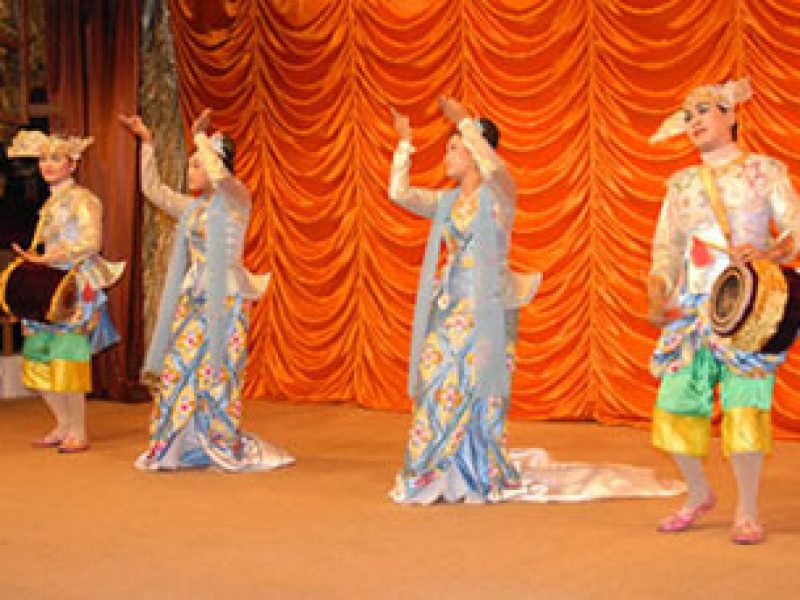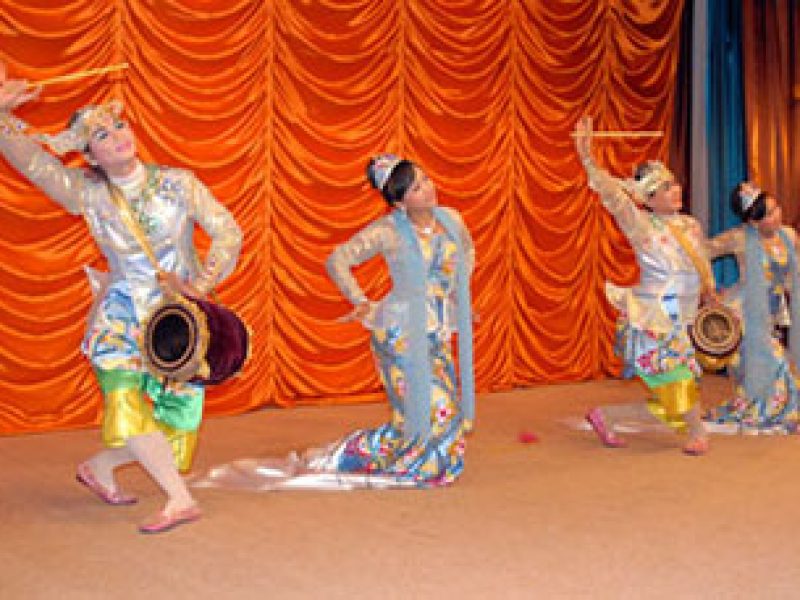Myanmar folk dances developed together with folk music and songs. So they are inseparably linked with folk music and songs. These three performing arts are complementary and agro-based. As Myanmar is an agricultural country the majority of its people are peasants and their cultural performance reflect their occupation and daily life style. Just as their folk music and songs present and describe their daily chores. so also their folk dances mimic their production activities. Most or possibly all Myanmar folk dances are group dances performed on communal occasions. The following are some samplings of most pervasive and popular dances.


Ou: zi dance is a dance performed by the ou: zi drum players to the accompaniment of folk music and folk songs by a band of at least four instrumentalists namely an ou:zi. drum player. an oboe player. a cymbals player. and bamboo clapper player. The ou:zi dancer plays the ou:zi drum as he dances. He also sings and when he is tired. the cymbals player or bamboo clappers player takes over. Ou:zi dance steps are quick and movements are jerky. Solo and chorus singing alternate. The lyrics of the ou:zi song describes the special occasion for performing the ou:zi dance. the locality and the pagoda festival which it commemorates. The essential feature of ou:zi dance is the chanting of “Thangja” (thangyat) which is an antiphonal chant usually amusing or satirical sung to the accompaniment of ou:zi. The ou:zi dance is performed on all happy and joyous occasions. This folk dance creates a boisterous and pastoral festive atmosphere.
Dou:ba’ dance. another folk dance is performed with the same band of musicians as in the ou:zi dance. The only difference between ou:zi and dou:ba’ dances is the type of drum played by the dancers. Dou:ba’ is a double face drum slung by means of a strap on the neck of the player. Ou:zi is an elongted one-faced drum with a long body and open-ended tail or leg. It is slung on the shoulder of the player. Than: gja is also chanted in dou:ba’dance. Sometimes than:gja is composed extempore by a witty rhymester of the village. With boisterous percussion music. sonorous songs. agile dance steps and chanting of ‘amusing tha:gja’ the dou:ba’ waing (dou:ba’ party or band) is one of the most hilarious folk dances. It is performed at the pagoda festival and the novitiation ceremony. It is also a must when people gather to give community services or contribute voluntary labour such as digging water wells and tanks. building roads. repairing public and religious buildings. The dou:ba’ dance can agitate and inspire the public.
Bjo (Byaw) performance follows as a signal before announcing the conclusion of a religious deed especially alms-giving. donation. or novitiation or ordination ceremonies. Normally no dance is performed because bjo music is monotone and constant. But in some villagers some adults and even the aged. particularly the donors. because they are overwhelmed with rapture and joy over their deed of religious merit. are drawn into the dance to the bjo beat. The bjo dance developed as a consequence of these impromtu performances. Now-a-days there are professional bjo bands and dances of whom theMoe za bjo band is famous.
Boun gyi dance is performed in Upper Myanmar. It originated in Shwebo at the beginning of the Kon-baung dynasty (A.D. 1752-1885). It is staged by the owner of paddy land and participated by the cultivators. It is performed at planting and harvesting times. Boun gyi dance is slow as the music and song accompanying it are also slow. But the boun gyi’s sound is reverberating due to the blend of the clash of big brass cymbals and the boom of the drum beat.
Naban Zan dance another folk dance is the favourite of Myanmar rural folks. The name is derived from the hair style fashionable among young-sters in olden days. That hair style is called naban zan. Tufts of hair are tied on either side of the head to hang over the ear. The dancer is a boy of early teen with a naban zan hair style. circular paint of thanakha make-up on his cheeks. dressed like a young boy of old days and wearing a round “gold” pendant. “gold” bangles and anklets. He dances and prances boyishly to the percussion music played by a band of five to seven instrumentalists. This dance is staged on festive occasions. particularly for fund raising for social welfare and religious works.
myanmar-folk-dance2U Shway Yoe dance Some scholars opine that this folk dance appeared in the early days of British colonial rule. It is a comic dance performed by a male dressed like a typical old Myanmar gentleman with a long neatly trimmed moustache. a scarf around his neck. a spotted turban or headgear. a square patterned sarong around his waist. holding a lady’s open parasole in one hand. while the other hand is moving with dance gestures and he is making comic faces. He shakes his moustache. moves his head. eyeballs and eyebrows in tune with the music. Though an old gentleman formally dressed. he acts as if he is on the lookout for pretty young girls. His comics and antics raise laughter. It is said that the first actor of U Shway Yoe dance was the famous Myanmar cartoonist Shway Ta-Lay (U Ba Galay) who played the role of a comedian (old man U Shway Yoe) in a film entitled Taw Myaing Zunka Lwan Aung Hpan (Longing for Wilderness) produced by the New Burma Film Co. In some performances of this type another comic character is introduced in a supporting role. It is a female dancer with the role name of Daw Moe. Daw Moe is supposed to be a middle-aged spinster still hunting for a good husband. She dresses herself up and acts like a young lady and dances flirtingly with U Shway Yoe who does not like spinsters but who always runs after pretty young girls.The U Shway Yoe dance satirizes some Myanmars of the old upper class who become social misfits due to their idiosynracies and eccentricities. The dance aptly pokes fun at both the ageing male philanderer and fastidious spinster. It is a favourite dance not only in the countryside but also in town. The name Shway Yoe caught on in the art and commercial worlds. Even Sir George Scott Who served in Myanmar as a high ranking . ICS man in the early days of British colonial rule assumed the name Shway Yoe ” as his penname for his celebrated book the Burman: His life and Nations.
Myanmar performing arts of rural folks are time-honoured tangible aspects of Myanmar culture. Despite changes through past countries they survive with characteristic re and resiberice and pensistently contribute to remain as part and parcel of Myanmar folk culture. Mecamzation of agriculture. information technology superhighway. ultra modern transportation .etc. are the factors speedily and unavoidably contributing towards the fast moving. process of globalization in every field of human kind. including culture. But nations with deep roots in tradition. culture and history have their national cultural heritage that serves as a bulwark against the undesirable effects of globalization.
The Myanmar performing arts of rural folks are time-honoured. tangible aspects of Myanmar culture. Despite changes through past centuries they have survived with characteristic resilience to persistently remain as part and parcel of Myanmar culture. Mechanization of agriculture. the information technology and superhighway. ultra-modern transportation etc: are factors speedily and unavoidably contributing to the fast-moving globalization in every field. including culture. But nations with deep roots in traditions. culture and history have their national cultural heritage that serves as a bulwark against the undesirable effects of globalization.
